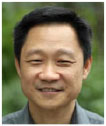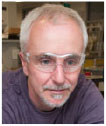The Chemistry of Guanidine, Guanidinium, and Guanidinate Compounds
Choon Hong Tan A and Martyn Coles B CA School of Physical and Mathematical Sciences, Division of Chemistry and Biological Chemistry, Nanyang Technological University, SPMS-CBC-04-18, 21 Nanyang Link, Singapore 637371.
B School of Chemical and Physical Sciences, Victoria University of Wellington, PO Box 600, Wellington, New Zealand.
C Corresponding author. Email: martyn.coles@vuw.ac.nz

Associate Professor Choon Hong Tan received his B.Sc. (Hons) First Class from the National University of Singapore (NUS) in 1995 and also topped his class that year. He graduated with his Ph.D. from the University of Cambridge in 1999. Following that, he spent two years in post-doctoral training at the Department of Chemistry and Chemical Biology, Harvard University. Subsequently, he worked as a Research Associate at the Department of Biological Chemistry and Molecular Pharmacology, Harvard Medical School, for another year before joining the Department of Chemistry, National University of Singapore, as Assistant Professor in 2003. He was promoted to Associate Professor in 2010, and moved to Nanyang Technological University (Singapore) in 2012. |

Associate Professor Martyn Coles received his B.Sc. (Hons) First Class from the University of Durham in 1992 and elected to stay in Durham for his Ph.D. studies under the supervision of Professor Vernon C. Gibson. He obtained a NATO Post-Doctoral Fellowship which he undertook in the University of Iowa in the USA with Professor Richard F. Jordan. After a second post-doctoral stint at the University of California, Berkeley, with Professor T. Don Tilley, he joined the faculty at the University of Sussex, UK, in 1999, where he was promoted to Senior Lecturer in 2005. In 2011, he moved to Victoria University of Wellington, New Zealand, where he is currently employed as an Associate Professor. |
Australian Journal of Chemistry 67(7) 963-964 https://doi.org/10.1071/CH14384
Published: 17 July 2014
Guanidine-based functional groups occur in many branches of chemistry, due in part to their ability to exist as neutral (guanidine), cationic (guanidinium), and anionic (guanidinate) entities. With such a rich chemistry, it is undoubtedly difficult for researchers to follow the development of so many aspects of guanidine chemistry, especially when results are published in a wide spectrum of journals. Thus, it is timely that we use this special issue of the Australian Journal of Chemistry to take stock and bring together a selection of the diverse research derived from these functionalities. We hope that through this collection we will help to cross-pollinate ideas and generate renewed interest in the chemistry of guanidines.
Guanidines are neutral, nitrogen-containing compounds and they are widely used as strong bases in synthetic organic chemistry. Understanding the origins of the high basicity of guanidine derivatives remains an important area of research.[1,2] It is this intrinsic property, coupled with the specific hydrogen-bonding pattern of its conjugate acid, the guanidinium ion, that has led to the increased use of guanidine derivatives as catalysts. The preparation of chiral guanidine derivatives as enantioselective catalysts has led to several successful reactions being reported,[3] and this special issue features several catalysts in this research area.[4–8]
The active sites of many enzymes contain the amino acid arginine and new derivatives of this compound continue to be developed.[9] Due to its high pKa value, arginine’s side chain remains protonated over a wide pH range, including at physiological pH. It is well known for interacting with anionic groups such as phosphates, nucleotide bases, and carboxylate-containing biomolecules through hydrogen bonding. Thus the guanidine group has an important role in biological systems,[10] and new routes to the synthesis of guanidine-containing compounds remains an important topic.[11]
This naturally occurring affinity for a host of anions and propensity to form strong hydrogen bonds have led to the development of guanidines, and their cationic guanidinium cations, as tectons employed by crystal engineers in supramolecular chemistry.[12] The cationic guanidinium unit has also featured in the development of ionic liquid crystals, where it is used as a charged head-group.[13]
It was with great sadness that the editorial team heard of the loss of two of the pioneering researchers in metal guanidinate chemistry during the preparation of this issue. Those familiar with the multitude of compounds and ligand systems investigated by Professor Michael (Mike) Lappert during his long and productive career may not be too surprised to find that he is accredited as the first person to report the synthesis of transition metal guanidinate complexes, generated by the insertion of carbodiimides into group 4 metal-amide ligands in 1970.[14] Perhaps less well known, however, is the fact that during his early career Professor Kenneth (Ken) Wade, predominantly known for his work on the Polyhedral Skeletal Electron Pair Theory (PSEPT, or Wade’s rules), first reported the deprotonated form of tetramethylguanidine as the lithium salt in 1968.[15] It is due to the foundations laid down by these giants of inorganic chemistry that metal guanidinate research has developed into such a large and important field today.[16–23]
The most widespread use of the guanidine functional group in coordination chemistry is as the anionic guanidinate,[24–26] although it may also bind effectively to a metal centre as a neutral fragment.[27,28] A common theme featuring in this collection of articles is the use of the guanidinate anion to support multiple metal centres as a bridging ligand, in which the metallic elements may[29] or may not[30–32] exhibit metal–metal bonding.
This area of chemistry continues to evolve and the diversity of applications of guanidine-containing compounds represented in this collection include their incorporation in high-energy materials[33] as compounds for CO2 fixation,[34] and as a component of redox-active switches.[35] We eagerly look forward to further developments in the future.
We wish to highlight the review articles contained herein, dealing with the subjects of guanidines in biologically active peptides,[10] the application of guanidine compounds in the capture and fixation of CO2,[34] guanidinates as ligands in chemical vapour deposition (CVD) and atomic layer deposition (ALD) applications,[36] and multiply bonded metal–metal compounds supported by bicyclic guanidinates as strong reducing agents.[29] We hope that these will be a valuable resource for those working in the respective areas.
Finally we extend our sincerest thanks to all contributing authors and colleagues who have taken the time and significant effort to make this special issue a truly international effort. Last but not least, we wish you an enjoyable time reading these papers!
References
[1] Z. Glasovac, M. Eckert-Maksić, Aust. J. Chem. 2014, 67, 1056.| Crossref | GoogleScholarGoogle Scholar |
[2] V. Štrukil, E. Lekšić, E. Meštrović, M. Eckert-Maksić, Aust. J. Chem. 2014, 67, 1129.
| Crossref | GoogleScholarGoogle Scholar |
[3] D. Leow, C.-H. Tan, Chem. Asian J. 2009, 4, 488.
| Crossref | GoogleScholarGoogle Scholar | 1:CAS:528:DC%2BD1MXks1Cht7Y%3D&md5=a45f1b343c800492213f675cfdea6210CAS | 19101939PubMed |
[4] M. Odagi, K. Takayama, K. Furukori, T. Watanabe, K. Nagasawa, Aust. J. Chem. 2014, 67, 1017.
| Crossref | GoogleScholarGoogle Scholar |
[5] L. Zou, X. Bao, H. Zhang, Y. Song, J. Qu, B. Wang, Aust. J. Chem. 2014, 67, 1115.
| Crossref | GoogleScholarGoogle Scholar |
[6] T. Takeda, M. Terada, Aust. J. Chem. 2014, 67, 1124.
| Crossref | GoogleScholarGoogle Scholar |
[7] Z. Jing, J. Liu, K. F. Chin, W. Chen, C.-H. Tan, Z. Jiang, Aust. J. Chem. 2014, 67, 1119.
| Crossref | GoogleScholarGoogle Scholar |
[8] M. W. Wong, A. M. E. Ng, Aust. J. Chem. 2014, 67, 1100.
| Crossref | GoogleScholarGoogle Scholar |
[9] T. L. March, J. A. Freemont, G. Dumsday, M. R. Johnston, P. J. Duggan, Aust. J. Chem. 2014, 67, 997.
| Crossref | GoogleScholarGoogle Scholar |
[10] J. V. Alegre-Requena, E. Marqués-López, R. P. Herrera, Aust. J. Chem. 2014, 67, 965.
| Crossref | GoogleScholarGoogle Scholar |
[11] C.-J. Zeng, C.-J. Chen, C.-W. Chang, H.-T. Chen, T.-C. Chien, Aust. J. Chem. 2014, 67, 1134.
| Crossref | GoogleScholarGoogle Scholar |
[12] D. Dumitrescu, Y.-M. Legrand, N. Masquelez, A. van der Lee, M. Barboiu, Aust. J. Chem. 2014, 67, 1005.
| Crossref | GoogleScholarGoogle Scholar |
[13] J. C. Haenle, M. M. Neidhardt, S. Beardsworth, J. Kirres, A. Baro, S. Laschat, Aust. J. Chem. 2014, 67, 1088.
| Crossref | GoogleScholarGoogle Scholar |
[14] G. Chandra, A. D. Jenkins, M. F. Lappert, R. C. Srivastava, J. Chem. Soc. A 1970, 2550.
| Crossref | GoogleScholarGoogle Scholar | 1:CAS:528:DyaE3cXltVyqtLo%3D&md5=bbef764fee0ddebea61ed6ba617e50c4CAS |
[15] I. Pattison, K. Wade, B. K. Wyatt, J. Chem. Soc. A 1968, 837.
| Crossref | GoogleScholarGoogle Scholar | 1:CAS:528:DyaF1cXpsFCmsw%3D%3D&md5=f8a03cbba842f39e0c48c6e70b031f6cCAS |
[16] F. T. Edelmann, Adv. Organomet. Chem. 2013, 61, 55.
| Crossref | GoogleScholarGoogle Scholar | 1:CAS:528:DC%2BC2cXptVyktw%3D%3D&md5=608b1d8883edf8a0a15d355321590d54CAS |
[17] F. T. Edelmann, Chem. Soc. Rev. 2012, 41, 7657.
| Crossref | GoogleScholarGoogle Scholar | 1:CAS:528:DC%2BC38Xhs1ahtbrJ&md5=9f2091fd8407ef50e0f03f405f6932cdCAS | 22777063PubMed |
[18] C. Jones, Coord. Chem. Rev. 2010, 254, 1273.
| Crossref | GoogleScholarGoogle Scholar | 1:CAS:528:DC%2BC3cXkt1Gqtrw%3D&md5=e476c1a19ed2fba889ea78f90f23b07aCAS |
[19] A. A. Trifonov, Coord. Chem. Rev. 2010, 254, 1327.
| Crossref | GoogleScholarGoogle Scholar | 1:CAS:528:DC%2BC3cXkt1Gqtrg%3D&md5=28a0bfea2c3ac882b9f9d80ed13007fcCAS |
[20] F. T. Edelmann, Chem. Soc. Rev. 2009, 38, 2253.
| Crossref | GoogleScholarGoogle Scholar | 1:CAS:528:DC%2BD1MXovVSns74%3D&md5=50567a24c30c19d4378b4703e711c60eCAS | 19623348PubMed |
[21] M. P. Coles, Chem. Commun. 2009, 3659.
| Crossref | GoogleScholarGoogle Scholar | 1:CAS:528:DC%2BD1MXnslentLw%3D&md5=0bef196c004b3565f30822ca276ed1f9CAS |
[22] F. T. Edelmann, Adv. Organomet. Chem. 2008, 57, 183.
| Crossref | GoogleScholarGoogle Scholar | 1:CAS:528:DC%2BD1MXht1yrtrY%3D&md5=0d9354191101de999daa0b9664fd3bd6CAS |
[23] P. J. Bailey, S. Pace, Coord. Chem. Rev. 2001, 214, 91.
| Crossref | GoogleScholarGoogle Scholar | 1:CAS:528:DC%2BD3MXhslemsbg%3D&md5=09edc379a402080417babbec943e6769CAS |
[24] R. L. Melen, H. R. Simmonds, H. Wadepohl, P. T. Wood, L. H. Gade, D. S. Wright, Aust. J. Chem. 2014, 67, 1030.
| Crossref | GoogleScholarGoogle Scholar |
[25] R. Fernández-Galán, J.-A. Navarro, F. Carrillo-Hermosilla, A. Antiñolo, I. López-Solera, E. Villaseñor, Aust. J. Chem. 2014, 67, 1063.
| Crossref | GoogleScholarGoogle Scholar |
[26] P. Tutacz, R. Syre, C. G. Hrib, L. Hilfert, N. Frenzel, E. P. Burte, M. Kühling, F. T. Edelmann, Aust. J. Chem. 2014, 67, 1110.
| Crossref | GoogleScholarGoogle Scholar |
[27] M. P. Coles, Dalton Trans. 2006, 985.
| Crossref | GoogleScholarGoogle Scholar | 1:CAS:528:DC%2BD28XhtlGktL0%3D&md5=c724b6e2ad92741d2f760dcc9f8969b1CAS | 16474883PubMed |
[28] S. M. El-Hamruni, S. E. Sözerli, J. D. Smith, M. P. Coles, P. B. Hitchcock, Aust. J. Chem. 2014, 67, 1071.
| Crossref | GoogleScholarGoogle Scholar |
[29] C. A. Murillo, Aust. J. Chem. 2014, 67, 972.
| Crossref | GoogleScholarGoogle Scholar |
[30] L. Fohlmeister, C. Jones, Aust. J. Chem. 2014, 67, 1011.
| Crossref | GoogleScholarGoogle Scholar |
[31] F. A. Stokes, L. Kloo, P. J. Harford, A. J. Peel, R. J. Less, A. E. H. Wheatley, D. S. Wright, Aust. J. Chem. 2014, 67, 1081.
| Crossref | GoogleScholarGoogle Scholar |
[32] S. K. Adas, J. A. Ocana, S. D. Bunge, Aust. J. Chem. 2014, 67, 1021.
| Crossref | GoogleScholarGoogle Scholar |
[33] B. Hu, X. Jin, H. Jia, Z. Liu, C. Lv, Aust. J. Chem. 2014, 67, 1037.
| Crossref | GoogleScholarGoogle Scholar |
[34] S. Zhang, L.-N. He, Aust. J. Chem. 2014, 67, 980.
| Crossref | GoogleScholarGoogle Scholar |
[35] C. Krämer, U. Wild, O. Hübner, C. Neuhäuser, E. Kaifer, H.-J. Himmel, Aust. J. Chem. 2014, 67, 1044.
| Crossref | GoogleScholarGoogle Scholar |
[36] A. Kurek, P. G. Gordon, S. Karle, A. Devi, S. T. Barry, Aust. J. Chem. 2014, 67, 989.
| Crossref | GoogleScholarGoogle Scholar |


